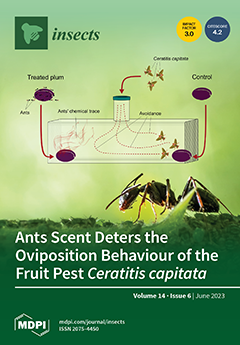It was reported that temperature affects the distribution of
Wolbachia in the host, but only a few papers reported the effect of the interaction between high temperature and
Wolbachia on the biological characteristic of the host. Here, we set four treatment
Drosophila melanogaster
[...] Read more.
It was reported that temperature affects the distribution of
Wolbachia in the host, but only a few papers reported the effect of the interaction between high temperature and
Wolbachia on the biological characteristic of the host. Here, we set four treatment
Drosophila melanogaster groups:
Wolbachia-infected flies in 25 °C (W
+M),
Wolbachia-infected flies in 31 °C (W
+H),
Wolbachia-uninfected flies in 25 °C (W
-M),
Wolbachia-uninfected flies in 31 °C (W
-H), and detected the interaction effect of temperature and
Wolbachia infection on the biological characteristic of
D. melanogaster in F
1, F
2 and F
3 generations. We found that both temperature and
Wolbachia infection had significant effects on the development and survival rate of
D. melanogaster. High temperature and
Wolbachia infection had interaction effect on hatching rate, developmental durations, emergence rate, body weight and body length of F
1, F
2 and F
3 flies, and the interaction effect also existed on oviposition amount of F
3 flies, and on pupation rate of F
2 and F
3 flies. High temperature stress reduced the
Wolbachia vertical transmission efficiency between generations. These results indicated that high temperature stress and
Wolbachia infection had negative effects on the morphological development of
D. melanogaster.
Full article






